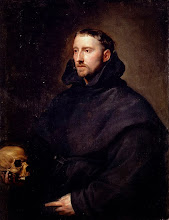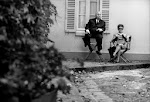Saturday, March 31, 2012
Friday, March 30, 2012
Caterpillar of feathers
Here’s a fantastic optical illusion courtesy of mother nature. What looks like a vibrantly colored caterpillar perched on a tree limb is actually photographer José Luis Rodríguez’s chance encounter with nine extra cozy European Bee-eaters. The photographer named the image Oruga de Plumas, which translates roughly to “Caterpillar of Feathers”.
Thursday, March 29, 2012
Tuesday, March 27, 2012
Monday, March 26, 2012
Sunday, March 25, 2012
Saturday, March 24, 2012
Friday, March 23, 2012
Thursday, March 22, 2012
Wednesday, March 21, 2012
Tuesday, March 20, 2012
Saturday, March 17, 2012
Friday, March 16, 2012
Thursday, March 15, 2012
Wednesday, March 14, 2012
Skyfall update from MI6
As MI6 reported at the weekend, 007 and M flee London to his home estate in Scotland, which is where the title of the film is taken. Whilst the main building, Skyfall Lodge, will be attacked (in a nice twist on the usual Bond film climax of the villain’s base being destroyed), it is a small secondary building that will hold the most interest to fans.
Also on the Bond family’s estate is a small chapel and a grave site for his parents Andrew Bond and Monique Delacroix who died in a climbing accident when he was a child. This literary back-story has been mentioned in passing by films before, specifically “GoldenEye”, but this will be the first time that the topic is faced head on by the character.
Also on the Bond family’s estate is a small chapel and a grave site for his parents Andrew Bond and Monique Delacroix who died in a climbing accident when he was a child. This literary back-story has been mentioned in passing by films before, specifically “GoldenEye”, but this will be the first time that the topic is faced head on by the character.
Construction on the buildings was completed yesterday in a hive of activity, with location filming scheduled for today with Daniel Craig. As the Foraging Photographer reports, even fake dead trees and artificial snow was used to dress the location to match shots filmed in Glencoe earlier this year.
Names on the Bond family gravestones include Robert Bond, Celia Bond, Valentine Bond, Kathleen Bond, and his parents Andrew Bond and Monique Delacroix Bond. The latter stone is marked “tragically departed” with the latin phrase “Mors Ultima Linea Rerum Est” (Death is Everything's Final Limit).
Tuesday, March 13, 2012
Monday, March 12, 2012
Sunday, March 11, 2012
Under the Wave off Kanagawa

'Under the Wave off Kanagawa' ('The Great Wave') is probably the most iconic Japanese artwork in the world. It depicts a monstrous wave about to come crashing down on three fishing boats and their crews. On the horizon is Mount Fuji, dwarfed by the colossal wave. The print was created by Hokusai when he was about seventy years old, as part of his Thirty-six views of Mount Fuji series.
The print was made using colour woodblock printing and many thousands of impressions were made - each one sold quite cheaply.
How did The Great Wave become one of the most famous images in the world?
When The Great Wave was first issued, in about 1830, Japan's contact with the outside world was strictly regulated. It was only in 1859 when Japan, under pressure from America and other
powers, opened a few of its ports that Japanese prints began to be exported to Europe. They were quickly discovered and celebrated by European and American artists like Whistler, Van Gogh and Monet. The Great Wave inspired Debussy's symphonic sketches La Mer and has become one of the most iconic images of the power of the sea.
'The Great Wave' is actually a view of Mt Fuji, one of a series of colour prints Hokusai designed about 1830 called Thirty-Six Views of Mt Fuji. The mountain has always been considered sacred and some of the original purchasers of the print, ordinary townspeople, were believers in the so-called 'Fuji cult'. They periodically made group pilgrimages to climb the mountain; although only men were allowed to go all the way to the top.
Mt Fuji is by far the highest mountain in Japan, but in Hokusai's print it is relegated to the far distance and dwarfed by the gigantic wave in the foreground. The spray from the wave starts to look like snow falling onto the peak of the mountain, a visual joke.
The eccentric composition of the print is a bravura display by Hokusai to show how he has digested supposedly 'rational' European-style perspective and made something much more dramatic and exciting out of it. When European artists and collectors began to discover and celebrate the print in the late nineteenth, they may well have been responding - consciously or unconsciously - to this European-influenced way of seeing that was deeply imbedded in the image.
Publisher Nishimuraya had craftsmen make many thousands of impressions of the image from sets of wooden printing blocks, maybe as many as 5,000-8,000. Gradually the blocks started to wear out and get damaged. So ideally one wants to see a relatively early impression, before the lines start to get blurred or broken and when the colours are still fitting neatly inside the outlines of the design. The fine, early impression recently acquired by the British Museum, although somewhat faded, is otherwise very sharp and fresh. You can see a unique woodgrain pattern in the black sky either side of Mt Fuji and there is the vestige of a pink cloud at the top.
Friday, March 09, 2012
Virgin Airlines
For all who have to work with rude customers; isn't it a shame we can't actually do this! An award should go to the Virgin Airlines desk attendant in Sydney some months ago for being smart and funny, while making her point, when confronted with a passenger who probably deserved to fly as cargo.
A crowded Virgin flight was cancelled after Virgin's 767s had been withdrawn from service. A single attendant was re-booking a long line of inconvenienced travellers. Suddenly an angry passenger pushed his way to the desk. He slapped his ticket down on the counter and said, "I HAVE to be on this flight and it HAS to be FIRST CLASS".The attendant replied, "I'm sorry, sir. I'll be happy to try to help you, but I've got to help these people first, and I'm sure we'll be able to work something out.."
The passenger was unimpressed. He asked loudly, so that the passengers behind him could hear,"DO YOU HAVE ANY IDEA WHO I AM?"
Without hesitating, the attendant smiled and grabbed her public address microphone:"May I have your attention please, may I have your attention please," she began - her voice heard clearly throughout the terminal. "We have a passenger here at Desk 14 WHO DOES NOT KNOW WHO HE IS.
If anyone can help him find his identity, please come to Desk 14."
With the folks behind him in line laughing hysterically, the man glared at the Virgin attendant, gritted his teeth and said, "F... You!" Without flinching, she smiled and said:
"I'm sorry, sir, but you'll have to get in line for that too.
"I'm sorry, sir, but you'll have to get in line for that too.
Thursday, March 08, 2012
Is The World An Idea?
Plato was one that made the divide between the world of ideas and the world of the senses explicit. In his famous Allegory of the Cave, he imagined a group of prisoners who had been chained to a cave all their lives; all they could see were shadows projected on a wall, which they conceived as their reality. Unbeknownst to them, a fire behind them illuminated objects and created the shadows they saw, which could be manipulated to deceive them. In contrast, the philosopher could see reality as it truly is, a manifestation of ideas freed from the deception of the senses. In other words, if we want to understand the true nature of reality, we shouldn't rely on our senses; only ideas are truly pure, freed from the distortions caused by our limited perception of reality.
Plato thus elevated the human mind to a god-like status, given that it can find truth through reason, in particular through the rational construction of ideal "Forms," which are the essence of all objects we see in reality. For example, all tables share the Form of "tableness," even if every table is different. The Form is an ideal and, thus, a blueprint of perfection. If I ask you to imagine a circle, the image of a circle you hold in your head is the only perfect circle: any representation of that circle, on paper or on a blackboard, will be imperfect. To Plato, intelligence was the ability to grasp the world of Forms and thus come closer to truth.
Due to its connection with the search for truth, it's no surprise that Plato's ideas influenced both scientists and theologians. If the world is made out of Forms, say geometrical forms, reality may be described mathematically, combining the essential forms and their relations to describe the change we see in the world. Thus, by focusing on the essential elements of reality as mathematical objects and their relations we could, perhaps, grasp the ultimate nature of reality and so come closer to timeless truths.
The notion that mathematics is a portal to final truths holds tremendous intellectual appeal and has influenced some of the greatest names in the history of science, from Copernicus, Kepler, Newton, and Einstein to many present-day physicists searching for a final theory of nature based upon a geometrical scaffolding, such as superstring theories.
For Platonist theologians, the notion that the ultimate reality is built from timeless Forms, mathematical and otherwise, supported the view that the world is the opus of an intelligent creator. Nicholas of Cusa, the brilliant 15th century papal legate in Germany, used such arguments in his "On Learned Ignorance" to claim that the Earth couldn't be the center of the universe, an idea that later inspired Copernicus and Giordano Bruno.
Cusa wrote:
"Since the center is a point equidistant from the circumference, and since it is impossible to have a sphere or a circle so perfect that a more perfect one could not be given, it clearly follows that a center could always be found that is truer and more exact than any given center. Only in God are we able to find a center which is with perfect precision equidistant from all points, for He alone is infinite equality."
Cusa goes as step beyond, acknowledging that, even though the only way to grasp for the truth is through our minds, a final truth is unachievable. We cannot know the mind of God.
Taken in context, we can see where modern scientific ideas that relate the ultimate nature of reality to geometry come from. If it's not God the Geometer anymore, Man the Geometer persists. That this vision offers a major drive to human creativity is undeniable.
We do imagine the universe in our minds, with our minds, and many scientific successes are a byproduct of this vision. Perhaps we should take Cusa's advice to heart and remember that whatever we achieve with our minds will be an expression of our own creativity, having little or nothing to do with ultimate truths.
Wednesday, March 07, 2012
Tuesday, March 06, 2012
Subscribe to:
Posts (Atom)







































































